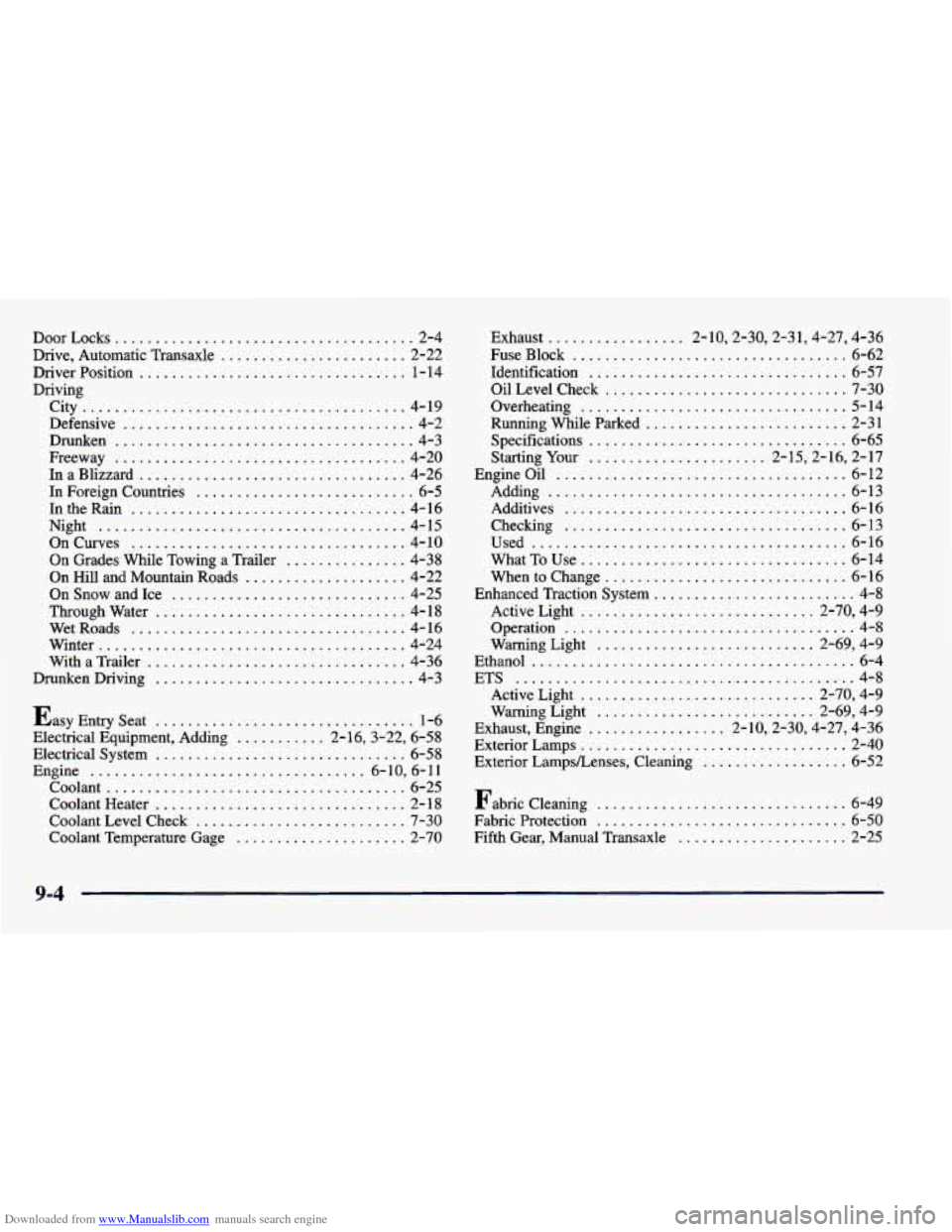overheating CHEVROLET CAVALIER 1998 3.G Owners Manual
[x] Cancel search | Manufacturer: CHEVROLET, Model Year: 1998, Model line: CAVALIER, Model: CHEVROLET CAVALIER 1998 3.GPages: 400, PDF Size: 20.74 MB
Page 146 of 400

Downloaded from www.Manualslib.com manuals search engine Enhanced Traction System Active Light Engine Coolant Temperature Gage
When your Enhanced
Traction System is limiting
wheel spin, this light will
LOW
TRAC
come on.
Slippery road conditions may exist
if the Enhanced
Traction System active light comes on,
so adjust your
driving accordingly.
The light will stay on for a few seconds after the
Enhanced Traction System stops limiting wheel spin.
The Enhanced Traction System active light also comes
on briefly when you
turn the ignition key to RUN. If the
light doesn’t come on then, have
it fixed so it will be
there to tell you when the system is active.
9
H
TEMP
Your vehicle is equipped with one of these gages.
With the ignition in
RUN, this gage shows the engine
coolant temperature.
If the gage pointer moves into the red area, your engine
is too hot! It means that your engine coolant has
overheated. If you have been operating your vehicle
under normal driving conditions, you should pull off the
road, stop your vehicle and turn
off the engine as soon
as possible.
In “Problems on the Road,” this manual shows what to
do. See “Engine Overheating” in the Index.
2-70
Page 218 of 400

Downloaded from www.Manualslib.com manuals search engine Wrn Signals When Towing a Trailer
When you tow a trailer, your vehicle may need a
different turn signal flasher and/or extra wiring. Check
with your Chevrolet dealer. The green arrows on your
instrument panel will flash whenever
you signal a turn
or lane change. Properly hooked up, the trailer lamps
will also flash, telling other drivers you’re about to turn,
change lanes or stop.
When towing a trailer, the green arrows on your
instrument panel will flash
for turns even if the bulbs on
the trailer are burned out. Thus, you may think drivers
behind you are seeing your signal when they
are not. It’s
important to check occasionally to be sure the trailer
bulbs are still working.
Driving On Grades
NOTICE:
Do not tow on steep continuous grades exceeding
6 miles (9.6 km). Extended, higher than normal
engine and transaxle temperatures may result
and damage your vehicle. Frequent stops are
very important
to allow the engine and transaxle
to cool.
Reduce speed and shift to a lower gear before you start
down a long or steep downgrade.
If you don’t shift
down, you might have to use your brakes
so much that
they would get hot and no longer work well.
On a long uphill grade, shift down and reduce your
speed to around
45 mph (70 km/h) to reduce the
possibility of engine and transaxle overheating.
Pay attention to the engine coolant gage. If the indicator
is in the red area, turn off the air conditioning (if you
have this option) to reduce engine load (see “Engine
Overheating” in the Index).
4-38
Page 220 of 400

Downloaded from www.Manualslib.com manuals search engine Maintenance When Trailer Towing
Your vehicle will need service more often when you’re
pulling a trailer. See the Maintenance Schedule for more
on this. Things that
are especially important in trailer
operation are automatic transaxle fluid (don’t overfill), engine oil, drive belt, cooling system and brake
adjustment. Each of these
is covered in this manual, and
the Index will help you find them quickly. If you’re
trailering, it’s a good idea to review these sections before you start your trip.
Check periodically
to see that all hitch nuts and bolts
are tight.
Engine Cooling When Trailer Towing
Your cooling system may temporarily overheat during
severe operating conditions. See “Engine Overheating”
in the Index.
Towing a Trailer (Except Models
with
2.4L Engine and 4-Speed
Automatic Transaxle)
Do not tow a trailer if your vehicle is:
a convertible model.
equipped with a 2.2L (Code 4) engine.
equipped with a manual transaxle or a three-speed
automatic transaxle.
4-40
Page 223 of 400

Downloaded from www.Manualslib.com manuals search engine 0 Section 5 Problems on the Road
Here you’ll find what to do about some problems that can occur on the road.
5-2
5-3
5-3
5-8
5-14
Hazard Warning Flashers
Other Warning Devices
Jump Starting
Towing Your Vehicle
Engine Overheating
5- 16
5-23
5-23
5-33
5-34
Cooling System
If a Tire Goes Flat
Changing a
Flat Tire
Compact Spare Tire
If You’re Stuck: In Sand, Mud,
Ice or Snow
5-1
Page 236 of 400

Downloaded from www.Manualslib.com manuals search engine Engine Overheating
You will find a coolant temperature gage and a low
coolant warning light on your vehicle’s instrument
panel. See “Engine Coolant Temperature Gage” and
“Low Coolant Warning Light’’ in the Index.
If Steam Is Coming From Your Engine
Steam from an overheated engine can burn you
badly, even if you just open the hood. Stay
away
from the engine if you see or hear steam coming
from it. Just turn it
off and get everyone away
from the vehicle until it cools down. Wait until
there is no sign
of steam or coolant before you
open the hood,
If you keep driving when your engine is
overheated, the liquids in
it can catch fire. You or
others could be badly burned. Stop your engine
if
it overheats, and get out of the vehicle until the
engine is cool.
NOTICE:
If your engine catches fire because you keep
driving with
no coolant, your vehicle can be
badly damaged, The costly repairs would not be
covered by your warranty.
5-14
Page 240 of 400

Downloaded from www.Manualslib.com manuals search engine If there seems to be no leak, with the engine on, check to
see
if the electric engine cooling fan is running. If the
engine is overheating, the fan should be running. If
it
isn’t, your vehicle needs service.
How to Add Coolant to the Coolant
Surge Tank
If you haven’t found a problem yet, but the coolant level
isn’t at the
FULL COLD mark, add a 50/50 mixture of
clean water (preferably distilled) and DEX-COOL@
coolant at the coolant surge tank, but be sure the cooling system, including the coolant surge tank pressure cap, is
cool before you do it. (See “Engine Coolant” in the
Index for more information.)
Steam and scalding liquids from a hot cooling
system can blow out and burn you badly. They
are under pressure, and
if you turn the coolant
surge tank pressure cap
-- even a little -- they
can
come out at high speed. Never turn the cap
when the cooling system, including the coolant
surge tank pressure cap,
is hot. Wait for the
cooling system and coolant surge tank pressure
cap to cool
if you ever have to turn the
pressure cap.
5-18
Page 283 of 400

Downloaded from www.Manualslib.com manuals search engine How to Check
You do not need to check the fluid level unless you
suspect a clutch problem.
To check the fluid level, take
the cap
off. If the fluid reaches the step inside the
reservoir, the fluid level is correct.
Engine Coolant
The cooling s stem in your vehicle is filled with
DEX-COOL
8 engine coolant. This coolant is designed
to remain in your vehicle for
5 years or 150,000 miles
(240 000 km) whichever occurs first, if you add only
DEX-COOL’ extended life coolant.
The following explains your cooling system and how
to add coolant when it is low. If you have a problem
with engine overheating, see “Engine Overheating” in
the Index.
A 50/50 mixture of water and DEX-COOL@
coolant will:
Give freezing protection down to -34°F (-37°C).
Give boiling protection up to 265 “F (129°C).
Protect against rust and corrosion.
Help keep the proper engine temperature.
Let the warning lights and gages work as
they should.
NOTICE:
When adding coolant, it is important that you
use only
DEX-COOL@ (silicate-free) coolant.
If coolant other than DEX-COOL is added to
the system, premature engine, heater core or
radiator corrosion may result. In addition, the
engine coolant will require change sooner
-- at
30,000 miles (50 000 km) or 24 months,
whichever occurs first. Damage caused by the
use of coolant other than DEX-COOL@ is not
covered by your new vehicle warranty.
6-25
Page 286 of 400

Downloaded from www.Manualslib.com manuals search engine Adding Coolant
If you need more coolant, add the proper DEX-COOL@
coolant mixture at the surge tank, but only when the
engine is cool.
I’
You can be burned if you spill coolant on hot
engine parts. Coolant contains ethylene glycol,
and
it will burn if the engine parts are hot
enough. Don’t spill coolant on a hot engine.
When replacing the pressure cap, make sure it is tight.
Surge Tank Pressure Cap
NOTICE:
Your surge tank cap is a 15 psi (105 kPa)
pressure-type cap and must be tightly installed to
prevent coolant
loss and possible engine damage
from overheating.
When you replace your surge tank pressure cap, a GM
cap is recommended.
Thermostat
Engine coolant temperature is controlled by a thermostat
in the engine coolant system. The thermostat stops the
flow of coolant through the radiator until the coolant
reaches
a preset temperature.
When
you replace your thermostat, an ACDelco
thermostat is recommended.
Page 298 of 400

Downloaded from www.Manualslib.com manuals search engine Windshield Wiper Blade Replacement Tires
Your new vehicle comes with high-quality tires made by
a leading tire manufacturer. If you ever have questions
about your tire warranty and where to obtain service, see
your Chevrolet Warranty booklet for details.
Replacement blades come in different types and are
removed in different ways. For the proper type and
length, see “Capacities and Specifications” in the Index.
Here’s how to remove the Shepherd’s
Hook type:
1. Pull the windshield wiper arm away from
2. Push the release lever and slide the wiper assembly
the
windshield.
toward the driver’s side
of the vehicle.
3. Install a new blade by reversing Steps 1 and 2.
Poorly maintained and improperly used tires
are dangerous.
0 Overloading your tires can cause
overheating as a result
of too much friction.
You could have an air-out and a serious
accident. See (‘Loading Your Vehicle” in
the Index.
Underinflated tires pose the same danger as
overloaded tires. The resulting accident
could cause serious injury. Check all tires
frequently to maintain the recommended
pressure. Tire pressure should be checked
when your tires are cold.
CAUTION: (Continued)
6-40
Page 386 of 400

Downloaded from www.Manualslib.com manuals search engine Door Locks ..................................... 2-4
Drive. Automatic Transaxle
....................... 2-22
Driver Position
................................. 1 - 14
Driving City
........................................ 4-19
Defensive
.................................... 4-2
Drunken
..................................... 4-3
Freeway
.................................... 4-20
In a Blizzard
................................. 4-26
In Foreign Countries
........................... 6-5
In
the Rain .................................. 4-16
Night
...................................... 4-15
On Curves
.................................. 4-10
On Grades While Towing a Trailer
............... 4-38
On Hill and Mountain Roads
.................... 4-22
On Snow and Ice
............................. 4-25
Through Water
............................... 4- 18
WetRoads
.................................. 4-16
Winter
...................................... 4-24
With a Trailer
................................ 4-36
Drunken Driving
................................ 4-3
Easy Entry Seat
................................ 1-6
Electrical Equipment. Adding
........... 2.16.3.22. 6.58
Electrical System
............................... 6-58
Engine
.................................. 6.10. 6.11
Coolant
..................................... 6-25
Coolant Heater
............................... 2- 18
Coolant Level Check .......................... 7-30
Coolant Temperature Gage
..................... 2-70 Exhaust
................. 2.10.2.30.2.31.4.27. 4.36
Fuse Block
.................................. 6-62
Identification
................................ 6-57
OilLevelCheck
.............................. 7-30
Overheating
................................. 5-14
Running While Parked
......................... 2-31
Specifications
................................ 6-65
Starting Your
...................... 2.15.2.16. 2.17
Engineoil
.................................... 6-12
Adding
..................................... 6-13
Additives
................................... 6-16
Checking
................................... 6-13
Used
....................................... 6-16
What To Use
................................. 6-14
Whentochange
.............................. 6-16
Enhanced Traction System
......................... 4-8
Active Light
............................. 2.70. 4.9
Operation
.................................... 4-8
Ethanol
........................................ 6-4
ETS
.......................................... 4-8
Active Light
............................. 2.70. 4.9
Warning Light
........................... 2.69. 4.9
Exhaust. Engine
................. 2.10.2.30.4.27. 4.36
Exterior Lamps
................................. 2-40
Exterior LampsLenses. Cleaning
.................. 6-52
Warning Light
........................... 2.69. 4.9
Fabric Cleaning
............................... 6-49
Fabric Protection
............................... 6-50
Fifth Gear. Manual Transaxle ..................... 2-25
9-4